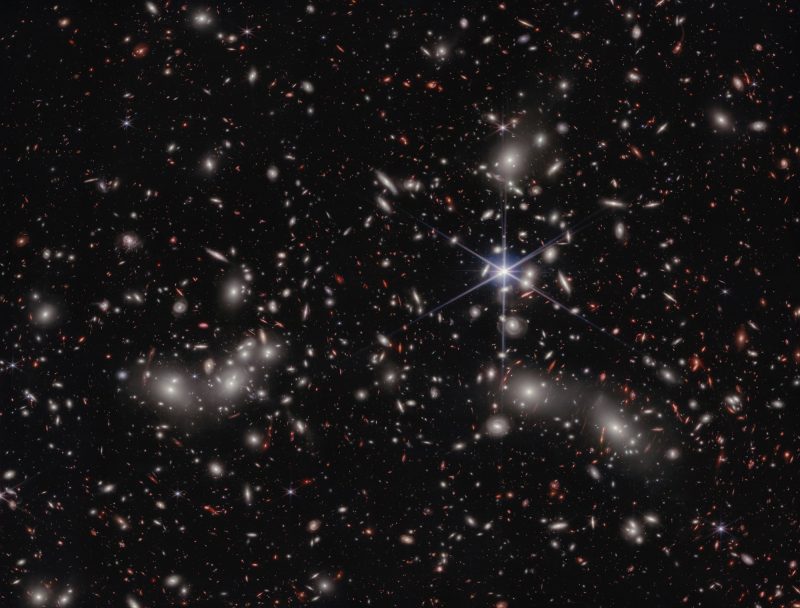
Pandora’s Cluster is the newest Webb deep field
When the James Webb Space Telescope achieved first light in July, 2022, we got to see the first deep-field image in infrared light. It was the farthest back in time we’d ever seen, and astronomers began breaking records with their discoveries of the oldest galaxies in the universe. Now, on February 15, 2023, NASA unveiled another Webb deep-field image, this time of Pandora’s Cluster (Abell 2744). In Pandora’s Cluster, three clusters are joining together to form a megacluster. This megacluster creates a gravitational lens, allowing us to see much more distant galaxies behind the cluster.
The new image is made from four different Webb images, stitched together to form a view of 50,000 sources in infrared light. The Hubble Space Telescope had only previously examined the group on the left in Pandora’s Cluster, in 2014.
Pandora from myth
Rachel Bezanson of the University of Pittsburgh in Pennsylvania is the co-principal investigator on the UNCOVER program that is studying Pandora’s Cluster. Bezanson said:
The ancient myth of Pandora is about human curiosity and discoveries that delineate the past from the future, which I think is a fitting connection to the new realms of the universe Webb is opening up, including this deep-field image of Pandora’s Cluster. When the images of Pandora’s Cluster first came in from Webb, we were honestly a little starstruck. There was so much detail in the foreground cluster and so many distant lensed galaxies, I found myself getting lost in the image. Webb exceeded our expectations.
Pandora’s Cluster as a gravitational lens
The mass of Pandora’s Cluster is so great that it bends the fabric of space, allowing a distorted view of background objects. For example, around the group of galaxies at lower right, we can see thousands of more-distant galaxies distorted into faint arcs. Ivo Labbe of the Swinburne University of Technology in Melbourne, Australia, is co-principal investigator on the UNCOVER program. Labbe said:
Pandora’s Cluster, as imaged by Webb, shows us a stronger, wider, deeper, better lens than we have ever seen before. My first reaction to the image was that it was so beautiful, it looked like a galaxy formation simulation. We had to remind ourselves that this was real data, and we are working in a new era of astronomy now.
Taking a closer look
Webb created this image of Pandora’s Cluster using 4- to 6-hour exposures for a total of about 30 hours of observing time. Next, the team will choose galaxies for further study with Webb’s Near-Infrared Spectrograph in the summer of 2023. From these observations, the astronomers hope to learn the galaxies’ compositions and precise distant measurements. This information will help them gain insights to how galaxies formed and evolved in the early universe.
In the meantime, you can take a closer look at the thousands upon thousands of galaxies for yourself.
Bottom line: The Webb space telescope took another deep-field image, this time targeting Pandora’s Cluster. The image reveals 50,000 sources in infrared light, including some far beyond the cluster that are made visible by the gravitational lens effect.











